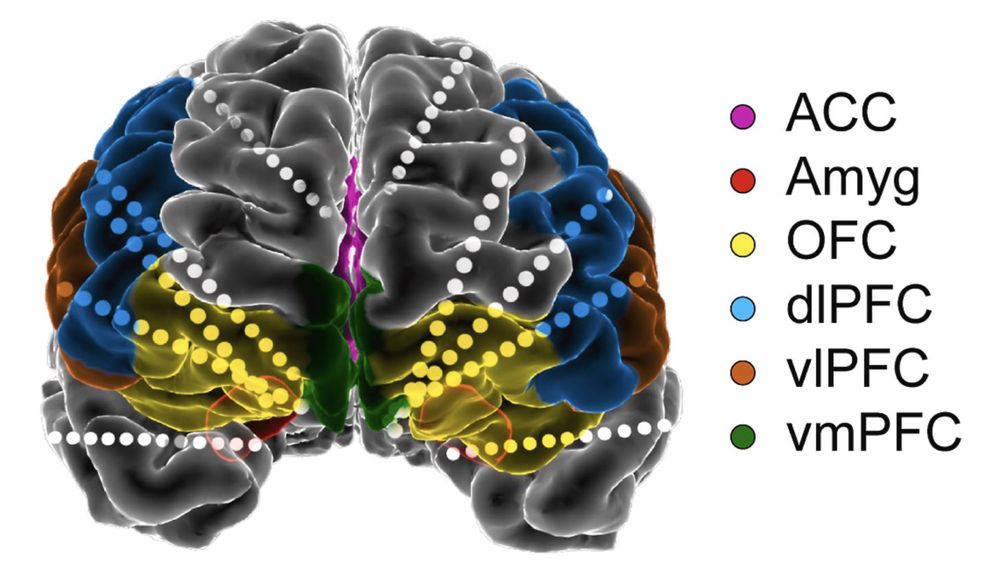A huge thank you to @SameerShethMD @NicoleProvenza @NeuroPolarbear and the entire team @JHUAPL for their help in bringing this vision to life! Stay tuned for future developments of this project 😉 (7/7)
28.10.2024 22:17 — 👍 0 🔁 1 💬 0 📌 0

Affective disorders remain among the most prevalent and hardest to treat psychiatric conditions. Our study offers a potential path forward in identifying relevant neural targets for improved diagnosis, assessment, and treatment for these challenging conditions. (6/7)
28.10.2024 22:17 — 👍 0 🔁 1 💬 1 📌 0

This work is the first step towards my goal of developing multimodal models for detection of affective state. Integrating across behavioral, physiological, and neural measures, this approach would enable analysis of affect in a more scalable, objective, and time-resolved way. (5/7)
28.10.2024 22:17 — 👍 0 🔁 1 💬 1 📌 0

We applied a speech emotion recognition model to extract continuous valence and arousal values. We then mapped the emotion features to neural activity and found that positive affect correlated with increased high-frequency and decreased low-frequency power across all regions. (4/7)
28.10.2024 22:17 — 👍 0 🔁 1 💬 1 📌 0

Instead, we used objective behavioral features to quantify emotion and identify neural biomarkers of emotional state. We recorded neural and audio data during daily social interactions in one patient participating in a clinical trial of DBS for treatment-resistant depression. (3/7)
28.10.2024 22:17 — 👍 0 🔁 1 💬 1 📌 0

Emotions are notoriously difficult to measure—they’re multi-dimensional and constantly changing. Traditional methods like self-report questionnaires are subjective and lack the temporal resolution needed to relate them to real-time neural dynamics. (2/7)
28.10.2024 22:17 — 👍 0 🔁 1 💬 1 📌 0

I’m excited to share our new paper in @brainstimj! We used natural human conversations to investigate the brain activity underlying emotional expression: https://www.brainstimjrnl.com/article/S1935-861X(24)00174-8/fulltext (1/7)
28.10.2024 22:17 — 👍 4 🔁 3 💬 1 📌 1
PhD student @ SINeLab (Technical University of Denmark). Exploring interpersonal temporal dynamics of social interaction - in the lab and out in the wild.
Assistant Professor @ ISMMS
NIH Director's Early Independence Awardee
Lindau Nobel Laureate Young Scientist
PI @ sinclaboratory.com
Using computational models, fMRI, & intracranial EEG to study social inference, learning, empathy, loneliness, & well-being
Mexican neuroscientists. Movie fan.
BUAP-UNAM 🇲🇽
Postdoc at BCM-Houston
Media psychologist, studying narratives & entertainment and why people spend time on them. Pop culture junkie, absolute nerd + social scientist
Postdoctoral Researcher at the Princeton Social Neuroscience Lab
Incoming Assistant Professor at Texas A&M - 2026
Computing Science prof in multimodal embodied AI, emotion, interaction at SFU in Vancouver 🇨🇦🇵🇭 Director of the Rosie Lab www.rosielab.ca Robotics nerd. Previously at SoftBank Robotics 🤖 FR/JP
Studies decision-making & emotions. Assoc. Prof. at Univ. of Denver, PI of the Sokol-Hessner Lab, Exec. Dir. of ASFP (www.asfp.io, @asfp.io), dad to 6 y.o. twins. He/Him
MD-PhD student at Paris Brain Institute, @Sorbonne-Universite.fr
Neurophysiologist working on LFP from #Subthalamic_Nucleus in #Parkinson's Disease
Neuroimaging research student • Exploring aging and the brain 🧠 • Sky gazer 🌌
#NeuroimagingGenetics #AI
Neurology south London trainee 🧠 (OOP-R; ST6) ⋅ Clinical Research Fellow & PhD candidate based at UCL Queen Square Institute of Neurology — #HD-YAS https://orcid.org/0000-0002-0679-0117
I talk about computational #openscience communication and science publishing. On the jupyterbook.org & @mystmd.org teams, co-founder of @curvenote.com & @continuous.foundation.
Mood & Memory researcher with a computational bent. https://www.nicolecrust.com. Science advocate. Prof (UPenn Psych) - on leave as a Simons Pivot Fellow. Author: Elusive Cures. https://press.princeton.edu/books/hardcover/9780691243054/elusive-cures
Cognitive neuroscience at MIT. Open science. 🇨🇦
Saxelab.mit.edu
Assistant Professor at Northwell
Previously McGill, Cornell, Yale
Brain-Based Predictive Modeling Lab: bpmlab.org
Interested in sex, gender, brain, behavior, mental health, neurodevelopment, and machine learning
Views are mine
🧠🇨🇦🇳🇵
Lab website: https://holmeslab.rutgers.edu/
Director, Yale Imaging & Psychopharmacology (YIP), Assoc Prof in Psychiatry & Child Study, addiction, mood, neuroimaging, tries to predict clinical stuff
Neuroscientist and psychologist interested in better treatments, brains & psychosis. Research Fellow @UniMelb @orygen_aus
Postdoc@Jacob Vogel ⬅️ PhD@Thomas Yeo. Neurodegenerative Disease, Brain Imaging, Machine Learning, Multi-omics
https://anlijun.cn
News & Views on Brain mapping | Machine-Learning | Translational Neuroscience. And triathlon
Director INM-7 FZ Jülich; Professor for Systems Neuroscience HHU Düsseldorf
Professor | Weill Cornell Medicine Radiology & Cornell University.
Computational neuroimaging, women’s brain health, neuroAI, psychedelics, brain-behavior mapping. Mom, jogger, avid reader.
Lab site: cocolaboratory.com
Bowers WBHI: wbhi.ucsb.edu





